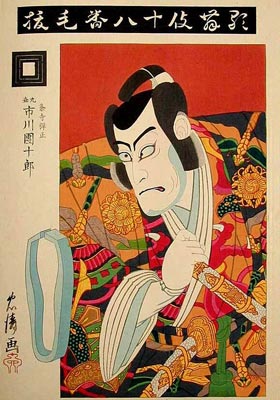| KENUKI |
| Play title | Narukami Fud˘ Kitayama Zakura |
| Authors | Tsuuchi Hanjűr˘/Yasuda Abun/Nakata Mansuke (1742) Oka Onitar˘ (1909) |
| History |
The first version of "Kenuki" was staged within the drama "Narukami Fud˘ Kitayama Zakura" in the 1st lunar month of 1742 in ďsaka at the ďnishi no Shibai [casting], starring Ichikawa Ebiz˘ II in the leading role of Kumedera Danj˘. This role was transmitted from generation to generation up to Ichikawa Danjűr˘ VII, who added it to his Kabuki Jűhachiban. Then it went into oblivion. "Kenuki" was fortunately revived by Ichikawa Sadanji II, in September 1909 at the Meijiza [casting]. It is nowadays a popular play, which is staged quite often. |
| Structure |
"Kenuki" is the third act of the 5-act drama "Narukami Fud˘ Kitayama Zakura". |
| Key words | Jidaimono Kabuki Jűhachiban |
| Summary |
In the Y˘zei emperorĺs era (reign 876-884), peasantry were suffering because the drought continued. So the Imperial Court decided to pray for rain. Lord Ono no Harumichi inherited as a family treasure a poem written on a strip of paper by his ancestor, the famous poetess Ono no Komachi. According to the legend, this poem is effective to pray for rain. An imperial envoy is sent to the Ono palace but the box, which is supposed to contain the precious poem, is empty. Harumichi's chief retainer Yatsurugi Genba quickly puts the blame on Harumichi's son Harukaze and another senior retainer named Hata no Minbu, the two people who hold the key of the family treasure room. Genba is in fact a villain, secretly plotting the overthrow of the Ono family. He is of course responsible for the disappearance of the poem. Harumichi orders Minbu and Genba to investigate this affair. Lord Harumichi has a daughter named Nishiki-no-Mae, who is engaged with Lord Bun'ya no Toyohide, but their marriage is postponed because of Nishiki-no-Maeĺs strange illness. Her hair stands on end. Kumedera Danj˘, a retainer of the Lord Toyohide, arrives at Harumichiĺs mansion to see Nishiki-no-Mae who is sick in bed. He is welcomed by Minbu and Genba and, introduced to Nishiki-no-Mae, he can witness the strange phenomemon. While he is waiting alone, he tries to lust after a cute page who brings him a smoking tool (the page is Hata no Hidetar˘, the younger brother of Minbu), then he tries the same thing with the lady-in-waiting Makiginu who brings him some tea. Then, he decides to shave his face with a giant pair of tweezers. Danj˘ puts the pair of tweezers on the floor, which suddenly start to float up into mid air. The reason is simple: a magnet is hidden somewhere. Harukaze had a mistress named Koiso, and she left from the mansion in order to bear the child of Harukaze at her home. However, Koiso was murdered, and the murderer stole the treasure of the Ono family, the poem, that she kept with her. The murderer decides to visit the Ono's mansion, pretending to be Koisoĺs elder brother Ohara Manbŕ, in order to blackmail the Ono family, saying that her daughter died when she gave birth to Harukaze's son. Danj˘ kills him with a dagger because he has already met the real Manbŕ before, and has heard what happened to Koiso. Danj˘ takes a strip of paper from the dead body. This is Ono no Komachi's precious poem, which is given back to Harumichi. Then Danj˘ takes out the hair ornament from Nishiki-no-Maeĺs head, and her hair stops standing. The hair ornament was made in iron. Danj˘ pokes the ceiling with a spear, and a ruffian who holds a big magnet falls down from there. Then, Genba kills the ruffian on the spot in order to avoid any confession from him. Lord Harumichi gives a sword to Danj˘ as a token of gratitude. But Danj˘ suddenly slashes Genba, who dies. Lord Toyohide suspected that Genba plotted to take over the Ono family, so he sent Danj˘ to Harumichiĺs mansion in order to solve every problem that happened there. And Kumedera Danj˘ did it well. This summary has been written by Sekidobashi Sakura (April 2005) and edited by Sh˘riya Aragor˘ |
| Comments |
As an old-fashioned play there are a number of other interesting features to mention. Kabuki's traditional stylisation is employed to the full in such things as character type, costume, make-up and props. We have the typical good retainer and bad retainer, the lord in his omigoromo, (large brocade outer coat with tuxedo collar), and the akahime, "red princess", dressed entirely in crimson with a silver tiara. Each role type has its own fixed role patterns and vocal delivery making for an interesting contrast. With regard to props, they play a more important part than usual in this play and, in keeping with the aragoto acting-style of the hero, are at times exaggerated in size so that, for example, at one point we see a giant pair of tweezers float up into mid air. (The Japanese word, kenuki means "tweezers".) The use of such props adds to the atmosphere of fantasy that is so enjoyable, and perhaps the "crowning" touch is when the evil retainer's head is decapitated and it literally flies through the air on a stick! Courtesy of Paul M. Griffith |
 |
 |
|
The actor Ichikawa Danjűr˘ VII playing the role of Kumedera Danj˘ in the drama "Ky˘ M˘de Narukami Zakura", which was staged in the 6th lunar month of 1812 at the Ichimuraza (print made by Utagawa Toyokuni I) |
The actor Ichikawa Danjűr˘ IX playing the role of Kumedera Danj˘ in the drama "Kenuki", which belong to the Kabuki Jűhachiban (print made by Torii Kiyosada) |
|
|
| Contact | Main | Top | Updates | Actors | Plays | Playwrights | Programs | Links | FAQ | Glossary | Chronology | Illustrations | Prints | Characters | Derivatives | Theaters | Coming soon | News |